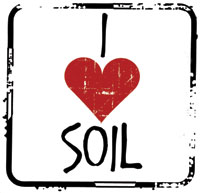How Do I Love Soil? Let Me Count the Ways
Posted: February 13, 2015
By Nick Goeser
As Valentine’s Day approaches in this International Year of Soils, I found it fitting to stream a little Elizabeth Barrett Browning and think about how we show our love for soil. Two of the best ways we can show our love for soil are to appreciate the important role it plays in our lives and to think about how we can work together to improve soils.
In December, Suzy Friedman, Environmental Defense Fund’s Director of Agricultural Sustainability, invited me to discuss the many reasons soils are important to food production. Soil health is directly linked to a resilient food supply. Beyond food, healthy soils function to support our urban parks and recreation areas, as well as fiber and fuel production at home and across the globe.
Just think – where do Valentine’s Day roses grow best? In soil! Where does Valentine’s Day chocolate come from? Cocoa trees growing in the tropical soils around the world. Soil is the common thread that weaves the most important parts of our lives together. So this year as you get ready to sit down to your Valentine’s Day dinner, take a few moments to think about what would be on it without soil.
How can we work together to improve the soils we love? Partnerships. Many partnerships are focused on improving soil health and conservation – some of which include The Soil Health Partnership, The Conservation Technology Information Center, The Conservation Cropping System Initiative and The Soil Renaissance. These partnerships serve as a means for diverse organizations to come together to achieve common goals – and they are making great progress. Together, many partnerships are helping farmers lead the way by adding support and information to make complex conservation decisions.
The Soil Health Partnership recently held its first Soil Health Summit. This gathering served as a venue for the farmers, agronomists and collaborators of the Soil Health Partnership to share knowledge and talk about innovative ways to improve soil health. We also opened the summit to the non-agricultural members of the public to open the dialogue between farmers and our urban neighbors. Together, these groups spent time discussing modern agriculture and innovation in conservation.
Participants spoke to our common goals. “I see the value in soil conservation and nutrient reduction because I think that they can help address an issue that our urban populations are very concerned about as well– our clean water,” commented Soil Health demonstration farmer Tim Smith. “We need to reach a lot of people – not just the farmers, urban soils are also very important. It is not only about creating a more desirable urban environment, but also for people in an urban environment to be aware of soils and how important they are. It is not only about farming,” said Dr. Harold van Es, Cornell Professor of Soil and Water Management.
Whether urban or agricultural, soils are essential to our daily lives. We must continue to work together through partnerships and collaborations to gather the information to help protect one of our most valuable resources.
About the author: Nick Goeser is NCGA’s manager for soil health and sustainability.
To track soil health and talk about it on social media, use #soilhealth2015.





